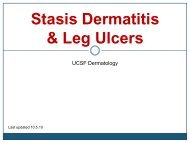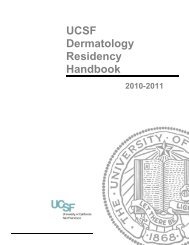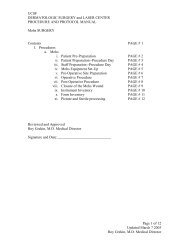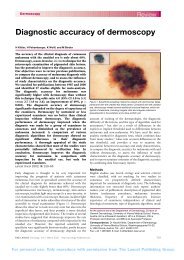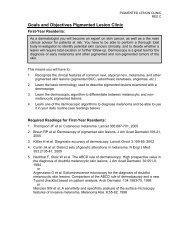Psoriasis - Dermatology
Psoriasis - Dermatology
Psoriasis - Dermatology
Create successful ePaper yourself
Turn your PDF publications into a flip-book with our unique Google optimized e-Paper software.
Last updated 9.9.10<br />
<strong>Psoriasis</strong><br />
Medical Student Core Curriculum<br />
in <strong>Dermatology</strong><br />
Spring 2011
Module Instructions<br />
The following module contains a number<br />
of blue, underlined terms which are<br />
hyperlinked to the dermatology glossary,<br />
an illustrated interactive guide to clinical<br />
dermatology and dermatopathology.<br />
We encourage the learner to read all the<br />
hyperlinked information.
Goals and Objectives<br />
The purpose of this module is to help medical<br />
students develop a clinical approach to the<br />
evaluation and initial management of patients<br />
presenting with psoriasis.<br />
After completing this module, the medical<br />
student will be able to:<br />
• Identify and describe the morphology of psoriasis<br />
• Describe the clinical features of psoriatic arthritis<br />
• List the basic principles of treatment for psoriasis<br />
• Discuss the psychosocial impact of psoriasis<br />
• Develop an initial treatment plan, including patient<br />
education
<strong>Psoriasis</strong>: The Basics<br />
<strong>Psoriasis</strong> is a chronic multisystem disease with<br />
predominantly skin and joint manifestations<br />
Affects approximately 2% of the U.S. population<br />
Age of onset occurs in two peaks: ages 20-30 and<br />
ages 50-60, but can be seen at any age<br />
Waxes and wanes during a patient’s lifetime, is often<br />
modified by treatment initiation and cessation, and has<br />
few spontaneous remissions<br />
There is a strong genetic component<br />
• About 30% of patients with psoriasis have a first-degree<br />
relative with the disease
Classification of <strong>Psoriasis</strong><br />
Classification is based on morphological descriptions<br />
The types of psoriasis are:<br />
• Plaque: scaly, erythematous patches, papules, and plaques that<br />
are often pruritic<br />
• Inverse: lesions are located in the skin folds<br />
• Erythrodermic: generalized erythema covering nearly the entire<br />
body surface area with varying degrees of scaling<br />
• Pustular: clinically apparent pustules<br />
• Rare, acute generalized variety called “von Zumbusch variant”<br />
• Palmoplantar – localized involving palms and soles<br />
• Guttate: presents with dew-drop lesions, 1-10mm salmon-pink<br />
papules with a fine scale<br />
Clinical findings in patients frequently overlap in more than<br />
one category<br />
Different types of psoriasis may require different treatment
A<br />
What Type of <strong>Psoriasis</strong>?<br />
C D<br />
B
Guttate <strong>Psoriasis</strong><br />
Acute onset of raindropsized<br />
lesions on trunk<br />
and extremities in<br />
young adults, often<br />
preceded by<br />
streptococcal<br />
pharyngitis
Inverse <strong>Psoriasis</strong><br />
Erythematous plaques<br />
in the axilla, groin,<br />
inframammary region,<br />
and other flexural areas.<br />
May lack scale due to<br />
moistness of area.
Pustular <strong>Psoriasis</strong><br />
Characterized by psoriatic lesions with pustules. Often<br />
triggered by corticosteroid withdrawal. When<br />
generalized, pustular psoriasis can be a lifethreatening.<br />
These patients should be hospitalized and<br />
a dermatologist consulted.
Palmoplantar <strong>Psoriasis</strong><br />
May occur as either plaque type or pustular type.<br />
Often very functionally disabling for the patient.<br />
The skin lesions of reactive arthritis typically occur<br />
on the palms and soles and are indistinguishable<br />
from this form of psoriasis.
Psoriatic Erythroderma<br />
Involves almost the entire<br />
skin surface; skin is bright<br />
red. Associated with fever,<br />
chills, and malaise. Like<br />
pustular psoriasis,<br />
hospitalization is sometimes<br />
required.<br />
* See module on<br />
erythroderma for more<br />
information
Question<br />
How would you describe these lesions?<br />
What type of psoriasis does this patient have?
Plaque <strong>Psoriasis</strong><br />
Well-demarcated plaques with overlying silvery<br />
scale and underlying erythema<br />
• micaceous scale – peels in layers<br />
Chronic plaque psoriasis is typically symmetric and<br />
bilateral<br />
Plaques may exhibit:<br />
• Auspitz sign (bleeding after<br />
removal of scale)<br />
• Koebner phenomenon<br />
(lesions induced by trauma)
Plaque <strong>Psoriasis</strong>: The Basics<br />
PLAQUE PSORIASIS is the most common form,<br />
affecting 80-90% of patients<br />
Approximately 80% of patients with plaque<br />
psoriasis have mild to moderate disease –<br />
localized or scattered lesions covering less than<br />
5% of the body surface area (BSA)<br />
20% have moderate to severe disease affecting<br />
more than 5% of the BSA or affecting crucial<br />
body areas such as the hands, feet, face, or<br />
genitals
<strong>Psoriasis</strong>: Pathogenesis<br />
<strong>Psoriasis</strong> is a hyperproliferative state<br />
resulting in thick skin and excess scale<br />
Skin proliferation is caused by cytokines<br />
released by immune cells<br />
Systemic treatments of psoriasis target<br />
these cytokines and immune cells
Case One<br />
Mr. Ronald Gilson
Case One: History<br />
HPI: Mr. Gilson is a 24 year-old gentleman<br />
who presents with a red lesion around his<br />
belly button that has been present for one<br />
month with occasional itching.<br />
He has been reading on the internet and<br />
asks: “Do I have psoriasis?”
Case One, Question 1<br />
What elements in the history are<br />
important to ask when considering the<br />
diagnosis of psoriasis?<br />
a. Recent illnesses / Past medical history<br />
b. Medications<br />
c. Family history<br />
d. Social history<br />
e. All of the above
Case One, Question 1<br />
Answer: e<br />
What elements in the history are important to<br />
ask in this case to arrive at a diagnosis of<br />
psoriasis?<br />
a. Recent illnesses / Past medical history<br />
b. Medications<br />
c. Family history<br />
d. Social history<br />
e. All of the above
Ask About Past Medical History<br />
<strong>Psoriasis</strong> can be triggered by infections, especially<br />
streptococcal pharyngitis<br />
More severe in patients with HIV<br />
Up to 20% of psoriasis patients have psoriatic arthritis,<br />
which can lead to joint destruction<br />
There is a positive correlation between increased BMI and<br />
both prevalence and severity of psoriasis<br />
Patients with psoriasis may have an increased risk for<br />
cardiovascular disease and should be encouraged to<br />
address their modifiable cardiovascular risk factors<br />
<strong>Psoriasis</strong> has a serious impact on health-related quality of<br />
life (QOL)
Ask About Medication History<br />
<strong>Psoriasis</strong> can be triggered or exacerbated<br />
by a number of medications including:<br />
• Systemic corticosteroid withdrawal<br />
• Beta blockers<br />
• Lithium<br />
• Antimalarials<br />
• Interferons
Ask About Family History<br />
There is a strong genetic predisposition to<br />
developing psoriasis<br />
1/3 of psoriasis patients have a positive<br />
family history<br />
• However, this means up to 2/3 of patients<br />
with psoriasis do not have a family history<br />
of psoriasis, so a negative family history<br />
does not rule it out
Ask about Health-Related<br />
Behaviors<br />
Studies have revealed smoking as a risk<br />
factor for psoriasis<br />
Alcohol consumption is more prevalent in<br />
patients with psoriasis and it may increase<br />
the severity of psoriasis<br />
A higher BMI is associated with an increase<br />
prevalence and severity of psoriasis
Back to Case One<br />
Mr. Ronald Gilson<br />
Twenty-one year-old gentleman with<br />
red lesion around his umbilicus
Case One: History Continued<br />
PMH: no major illnesses or hospitalizations<br />
Medications: none<br />
Allergies: none<br />
Family history: adopted, does not know his<br />
family history<br />
Social history: lives with roommates in an<br />
apartment, graduate student in physics<br />
Health-related behaviors: no tobacco or drug<br />
use. Drinks 3-6 beers on weekends.<br />
ROS: negative
<strong>Psoriasis</strong>: Clinical Evaluation<br />
Although you should perform a full body<br />
skin exam, plaque psoriasis tends to<br />
appear in characteristic locations<br />
• Key Areas: scalp, ears, elbows and knees<br />
(extensor surfaces), umbilicus, gluteal cleft,<br />
nails, and sites of recent trauma<br />
• Observation of psoriatic lesions in these<br />
locations helps distinguish psoriasis from<br />
other papulosquamous (scaly) skin disorders
Back to Case One: Skin Exam<br />
Erythematous plaque<br />
with small amount of<br />
fine overlying scale<br />
around the umbilicus<br />
Erythematous plaque<br />
with overlying silvery<br />
scale is present in the<br />
gluteal cleft
DDx of <strong>Psoriasis</strong><br />
Mr. Gilson is given a diagnosis of psoriasis<br />
based on the clinical evaluation<br />
<strong>Psoriasis</strong> is typically diagnosed on clinical exam<br />
because of its characteristic location and<br />
appearance<br />
Other conditions to be considered in the patient<br />
with chronic plaque psoriasis are:<br />
• Tinea corporis<br />
• Nummular eczema<br />
• Seborrheic dermatitis<br />
• Secondary syphilis<br />
• Drug eruption
Case Two<br />
Mr. Bruce Laney
Case Two: History<br />
HPI: Mr. Laney is a 68 yo gentleman with a history of<br />
psoriasis who presents with increased joint pain and<br />
joint changes. He currently uses a topical steroid to<br />
treat his psoriasis.<br />
PMH: psoriasis x 40yrs (difficult to control).<br />
Hypertension x 20 years, well-controlled with thiazide<br />
Medications: topical clobetasol for psoriasis,<br />
hydrochlorothiazide for blood pressure<br />
Allergies: none<br />
FH: mother and father both had psoriasis<br />
SH: lives with his wife in a house, retired, no children<br />
ROS: negative
Case Two: Skin Exam<br />
Large erythematous<br />
plaque with overlying<br />
silvery scale on<br />
anterior scalp<br />
Erythematous plaque<br />
with overlying silvery<br />
scale at the external<br />
auditory meatus and<br />
behind the ear
Case Two: Exam Continued<br />
Extensor surface<br />
of the left arm has<br />
erythematous<br />
plaques with<br />
overlying silvery<br />
scale<br />
Also with vitiligo<br />
and macular<br />
depigmentation in<br />
the same region<br />
Nail pitting
Case Two: Exam Continued<br />
Erythematous and<br />
edematous foot, with<br />
dactylitis of the 2 nd digit,<br />
and destruction of the<br />
DIP joints<br />
Onychodystrophy
Case Two, Question 1<br />
Mr. Laney has psoriasis complicated by<br />
psoriatic arthritis. What part of his history<br />
or exam are most characteristic of a<br />
patient with psoriatic arthritis?<br />
a. history of extensive psoriasis<br />
b. presence of nail pitting<br />
c. use of clobetasol<br />
d. none of the above
Answer: b<br />
Case Two, Question 1<br />
Mr. Laney has psoriasis complicated by psoriatic<br />
arthritis. What part of his history/exam is most<br />
consistent with this diagnosis?<br />
a. history of extensive psoriasis<br />
b. presence of nail pitting (up to 90% of patients<br />
with psoriatic arthritis may have nail changes)<br />
c. use of clobetasol<br />
d. none of the above
Psoriatic Onychodystrophy<br />
Nail psoriasis can occur in all psoriasis subtypes<br />
Fingernails are involved in ~ 50% of all patients with<br />
psoriasis<br />
Toenails in 35%<br />
Changes include:<br />
• Pitting: punctate depressions of the nail<br />
plate surface<br />
• Onycholysis: separation of the nail<br />
plate from the nail bed<br />
• Subungual hyperkeratosis: abnormal<br />
keratinization of the distal nail bed<br />
• Trachyonychia: rough nails as if<br />
scraped with sandpaper longitudinally
Psoriatic Arthritis (PsA)<br />
Arthritis in the presence of psoriasis<br />
• A member of the seronegative spondyloarthropathies<br />
Symptoms can range from mild to severe<br />
Occurs in 10-25 percent of patients with psoriasis<br />
• Can occur at any age, but for most it appears between the ages<br />
of 30 and 50 years<br />
• It is NOT related to the severity of psoriasis<br />
Five clinical patterns of arthritis occur<br />
• Most common is oligoarthritis with swelling and tenosynovitis of<br />
one or a few hand joints<br />
Flares and remissions usually characterize the course of<br />
psoriatic arthritis
Psoriatic Arthritis Continued<br />
Health care providers are encouraged to actively<br />
seek signs and symptoms of PsA at each visit<br />
PsA may appear before the diagnosis of psoriasis<br />
If psoriatic arthritis is diagnosed, treatment should<br />
be initiated to:<br />
• Alleviate signs and symptoms of arthritis<br />
• Inhibit structural damage<br />
• Maximize quality of life<br />
Diagnosis is based on clinical judgment.<br />
• Specific patterns of joint inflammation, absence of<br />
rheumatoid factor, and the presence of skin and nail<br />
lesions of psoriasis aid clinicians in making the diagnosis of<br />
PsA
Psoriatic Arthritis<br />
Desquamation of the overlying<br />
skin as well as joint swelling and<br />
deformity (arthritis mutilans) of<br />
both feet<br />
Swelling of the PIP joints<br />
of the 2-4 th digits, DIP<br />
involvement of the 2 nd digit
Case Three<br />
Ms. Sonya Hagerty
Case Three: History<br />
HPI: Ms. Hagerty is an 18 year old healthy woman with a<br />
new diagnosis of psoriasis reports lesions localized to<br />
her knees with no other affected areas. She has not tried<br />
any therapy.<br />
PMH: none<br />
Medications: none<br />
Allergies: none<br />
Family history: non-remarkable<br />
Social history: lives in the city with her parents and<br />
attends high school<br />
Health-related behaviors:<br />
ROS: slight pruritus
Case Three: Skin Exam<br />
Erythematous plaques<br />
with overlying silvery<br />
scale on the extensor<br />
surface of the knee.
Case Three, Question 1<br />
Which of the following would you recommend<br />
to start treatment for Ms Hagerty’s psoriasis?<br />
a. systemic steroids<br />
b. immunomodulators<br />
c. high potency topical steroid<br />
d. low potency topical steroid<br />
e. all of the above
Answer: c<br />
Case Three, Question 1<br />
Which of the following would you recommend to<br />
start treatment for Ms Hagerty’s psoriasis?<br />
a. systemic steroids<br />
b. biologic<br />
c. high potency topical steroid<br />
d. low potency topical steroid<br />
e. Topical clotrimazole
<strong>Psoriasis</strong>: Treatment<br />
Since the psoriasis is localized (less than<br />
5% body surface area), topical treatment<br />
is appropriate<br />
First line agents: High potency topical<br />
steroid in combination with calcipotriene<br />
(vitamin D analog)<br />
Other topical options: tazarotene, salicylic<br />
or lactic acid, tar, calcineurin inhibitors
<strong>Psoriasis</strong>: Treatment<br />
Factors that influence type of treatment:<br />
• Age<br />
• Type of psoriasis:<br />
• plaque, guttate, pustular, erythrodermic psoriasis<br />
• Site and extent of psoriasis:<br />
• localized = 30% involvement<br />
• Previous treatment<br />
• Other medical conditions<br />
Patients with localized plaque psoriasis can be managed by<br />
a primary care provider<br />
<strong>Psoriasis</strong> of all other types should be evaluated by a<br />
dermatologist
<strong>Psoriasis</strong>: Topical Treatment<br />
Medication Uses in <strong>Psoriasis</strong> Side Effects<br />
Topical steroids Plaque-type psoriasis Skin atrophy,<br />
hypopigmentation, striae<br />
Calcipotriene<br />
(Vitamin D derivative)<br />
Tazarotene<br />
(Topical retinoid)<br />
Salicylic or Lactic acid<br />
(Keratolytic agents)<br />
Use in combination with topical<br />
steroids for added benefit<br />
Plaque-type psoriasis. Best when<br />
used with topical corticosteroids.<br />
Plaque-type psoriasis to reduce<br />
scaling and soften plaques<br />
Skin irritation, photosensitivity<br />
(but no contraindication with<br />
UVB phototherapy)<br />
Skin irritation, photosensitivity<br />
Systemic absorption can occur<br />
if applied to > 20% BSA.<br />
Decreases efficacy of UVB<br />
phototherapy<br />
Coal tar Plaque-type psoriasis Skin irritation, odor, staining of<br />
clothes<br />
Calcineurin inhibitors Off-label use for facial and<br />
intertriginous psoriasis<br />
Skin burning and itching
Estimating BSA via Palm of Hand<br />
1 Palm = 1%<br />
BSA
Estimating topicals:<br />
Fingertip unit<br />
Quantity of topical<br />
medication placed on<br />
pad of finger from distal<br />
tip to DIP joint<br />
Fingertip unit = 500 mg<br />
= treats 2% BSA
Estimating Topical Therapy<br />
Amounts<br />
2% BSA = 500mg = 0.5g<br />
• 2% BSA bid x 1 month = 0.5 g x 2 x 30 = 30 g<br />
• 5% BSA bid x 1 month = 1.25 g x 2 x 30 = 75 g<br />
Can also use the “Rule of 15”<br />
%BSA x 15 = grams needed to treat bid x 1 month<br />
• 10% BSA bid x 1 month = 150 g<br />
• 100% BSA bid x 1 month = 1500 g
Case Three, Question 2<br />
Which of the following<br />
prescriptions would you give<br />
Ms Hagerty?<br />
a. Clobetasol 0.05% ointment,<br />
applied BID<br />
b. Tacrolimus 0.1% ointment,<br />
applied BID<br />
c. Coal tar solution 10%, applied<br />
at bedtime<br />
d. Etanercept 50mg,<br />
subcutaneous, twice per week
Answer: a<br />
Case Three, Question 2<br />
Which of the following<br />
prescriptions would you use<br />
for Ms Hagerty?<br />
a. Clobetasol 0.05% ointment,<br />
applied BID<br />
b. Tacrolimus 0.1% ointment,<br />
applied BID<br />
c. Coal tar solution 10%, applied<br />
at bedtime<br />
d. Etanercept 50mg,<br />
subcutaneous, twice per week
Case Three, Question 3<br />
Which of the following prescriptions is<br />
correct for topical clobetasol 0.05%<br />
ointment for a 3 month supply?<br />
a. Clobetasol 0.05%, apply twice a day to the affected<br />
areas, dispense 30 grams<br />
b. Clobetasol 0.05%, apply twice day to the affected areas,<br />
dispense 3 grams<br />
c. Clobetasol 0.05%, apply twice a day to the affected<br />
areas, dispense 90 grams<br />
d. Clobetasol 0.05%, apply twice a day to the affected<br />
areas, dispense 9 grams
Case Three, Question 3<br />
Answer: c<br />
Which of the following prescriptions is correct for<br />
topical clobetasol 0.05% ointment for a 3 month<br />
supply?<br />
a. Clobetasol 0.05%, apply twice a day to the affected areas,<br />
dispense 30 grams<br />
b. Clobetasol 0.05%, apply twice day to the affected areas,<br />
dispense 3 grams<br />
c. Clobetasol 0.05%, apply twice a day to the affected areas,<br />
dispense 90 grams (2% BSA x 15 = 30 grams/month x 3 months<br />
= 90 grams)<br />
d. Clobetasol 0.05%, apply twice a day to the affected areas,<br />
dispense 9 grams
Clinical Pearl<br />
Topical medications for psoriasis are more<br />
effective when used with occlusion which<br />
allows for better penetration<br />
A bandage, saran-wrap, gloves, or socks<br />
placed over the medication can serve this<br />
purpose
Case Three, Question 4<br />
What would be an appropriate<br />
treatment if a patient had<br />
presented with this skin<br />
exam?<br />
a. systemic steroid<br />
b. topical steroid<br />
c. topical steroid and systemic<br />
steroid<br />
d. topical steroid and UV light<br />
therapy<br />
e. all of the above
Case Three, Question 4<br />
Answer: d<br />
What would be an appropriate<br />
treatment if a patient had<br />
presented with this skin exam?<br />
a. systemic steroid<br />
b. topical steroid<br />
c. topical steroid and systemic<br />
steroid<br />
d. topical steroid and UV light<br />
therapy<br />
e. all of the above
<strong>Psoriasis</strong>: System Treatment<br />
In patients with moderate to severe disease,<br />
systemic treatment can be considered and<br />
should be supplemented with topical treatment<br />
Many patients with moderate to severe psoriasis<br />
are only given topical therapy and experience<br />
little treatment success<br />
• Undertreating the patient can lead to a loss of hope<br />
regarding their disease<br />
Oral steroids should never be used in psoriasis<br />
as they can severely flare psoriasis upon<br />
discontinuation
Systemic Treatment<br />
There are 3 choices for systemic treatment:<br />
1. Phototherapy: narrow-band ultraviolet B light (nbUVB),<br />
broad-band ultraviolet B light (bbUVB), or psoralen plus<br />
ultraviolet A light (PUVA)<br />
2. Oral medications: methotrexate, acitretin, cyclosporine<br />
3. Biologic Agents: T- cell blocker (alefacept), TNF-α<br />
inhibitors (infliximab, etanercept, adalumimab), IL 12/23<br />
blocker (ustekinumab)<br />
The choice of systemic therapy depends on multiple<br />
factors: convenience, side effect risk profile, presence or<br />
absence of psoriatic arthritis (PsA), co-morbidities<br />
Systemic treatment for psoriasis should be given only<br />
after consultation with a dermatologist
The Patient’s Experience<br />
A successful treatment regimen should include<br />
patient education as well as provider awareness of<br />
the patient’s experience<br />
• Find out the patients’ views about their disease<br />
• Ask the patient how psoriasis affects their daily living<br />
• Ask about symptoms such as pain, itching, burning,<br />
and dry skin<br />
• Ask patients about their experience with previous<br />
treatments<br />
• Important to ask patients about their hopes and<br />
expectations for treatment<br />
• Provide time for patients to ask questions
<strong>Psoriasis</strong> and QOL<br />
<strong>Psoriasis</strong> is a lifelong disease and can affect all<br />
aspects of a patient’s QOL (even in patients with<br />
limited skin involvement)<br />
Remember to address both the physical and<br />
psychosocial aspects of psoriasis<br />
Many patients with psoriasis:<br />
• Feel socially stigmatized<br />
• Have high stress levels<br />
• Are physically limited by their disease<br />
• Have higher incidences of depression and alcoholism<br />
• Struggle with their employment status
Take Home Points<br />
<strong>Psoriasis</strong> is a chronic multisystem disease with predominantly skin<br />
and joint manifestations<br />
About 1/3 of patients with psoriasis have a 1 st -degree relative with<br />
psoriasis<br />
Different types of psoriasis are based on morphology: plaque,<br />
guttate, inverse, pustular, and erythrodermic<br />
Plaque psoriasis is the most common, affecting 80-90% of patients<br />
A detailed history should be taken in patients with psoriasis<br />
Plaque psoriasis is often diagnosed clinically<br />
Nail disease is common in patients with psoriasis<br />
Psoriatic arthritis is a member of the seronegative<br />
spondyloarthropathies
Take Home Points<br />
Health care providers are encouraged to actively seek signs and<br />
symptoms of psoriatic arthritis at each visit<br />
Topical treatment alone is used when the psoriasis is localized<br />
Topical medications for psoriasis are more effective when used with<br />
occlusion, which allows for better penetration<br />
Patients with moderate to severe disease often require systemic<br />
treatment in addition to topical therapy<br />
Oral steroids should never be used in psoriasis<br />
Systemic treatment includes phototherapy, oral medications and biologic<br />
agents.<br />
A succesful treatment plan should include patient education as well as<br />
provider awareness of the patient’s experience<br />
<strong>Psoriasis</strong> is a lifelong disease and can affect all aspects of a patient’s<br />
quality of life
End of the Module<br />
Abdelaziz A, Burge S. What should undergraduate medical students know about<br />
psoriasis? Involving patients in curriculum development: modified Delphi<br />
technique. BMJ 2005;330:633-6.<br />
Bremmer S et al. Obesity and psoriasis: From the Medical Board of the National<br />
<strong>Psoriasis</strong> Foundation. J Am Acad Dermatol 2009 article in press.<br />
Gelfand JM, et al. Risk of Mycocardial Infarction in Patients With <strong>Psoriasis</strong>.<br />
JAMA 2006;296:1735-41.<br />
Gottlieb et al. Guidelines of care for the management of psoriasis and psoriatic<br />
arthritis. Section 2. Psoriatic arthritis: Overview and guidelines of care for<br />
treatment with an emphasis on biologics. J Am Acad Dermatol 2008;58:851-864.<br />
Gudjonsson Johann E, Elder James T, "Chapter 18. <strong>Psoriasis</strong>" (Chapter). Wolff<br />
K, Goldsmith LA, Katz SI, Gilchrest B, Paller AS, Leffell DJ: Fitzpatrick's<br />
<strong>Dermatology</strong> in General Medicine, 7e:<br />
http://www.accessmedicine.com/content.aspx?aID=2983780.
End of the Module<br />
James WD, Berger TG, Elston DM, “Chapter 13. Acne” (chapter). Andrews’<br />
Diseases of the Skin Clinical <strong>Dermatology</strong>. 10 th ed. Philadelphia, Pa: Saunders<br />
Elsevier; 2006: 231-239, 245-248.<br />
Jobling R. A Patient’s Journey. <strong>Psoriasis</strong>. BMJ 2007;334:953-4.<br />
Kimball AB et al. The Pyschosocial Burden of <strong>Psoriasis</strong>. Am J Clin Dermatol<br />
2005;6:383-392.<br />
Luba KM, Stulberg DL. Chronic Plaque <strong>Psoriasis</strong>. Am Fam Physician<br />
2006;73:636-44.<br />
Menter A et al. Guidelines of care for the management of psoriasis and psoriatic<br />
arthritis. Section 1. Overview of psoriasis and guideline of acre for the treatment<br />
of psoriasis with biologics. J Am Acad Dermatol 2008;58:826-850.<br />
Menter A et al. Guidelines of care for the management of psoriasis and psoriatic<br />
arthritis. Section 3. Guidelines of care for the management and treatment of<br />
psoriasis with topical therapies. J Am Acad Dermatol 2009;60:643-659.<br />
Smith CH. Clinical Review. <strong>Psoriasis</strong> and its management. BMJ 2006;333:380-4.



